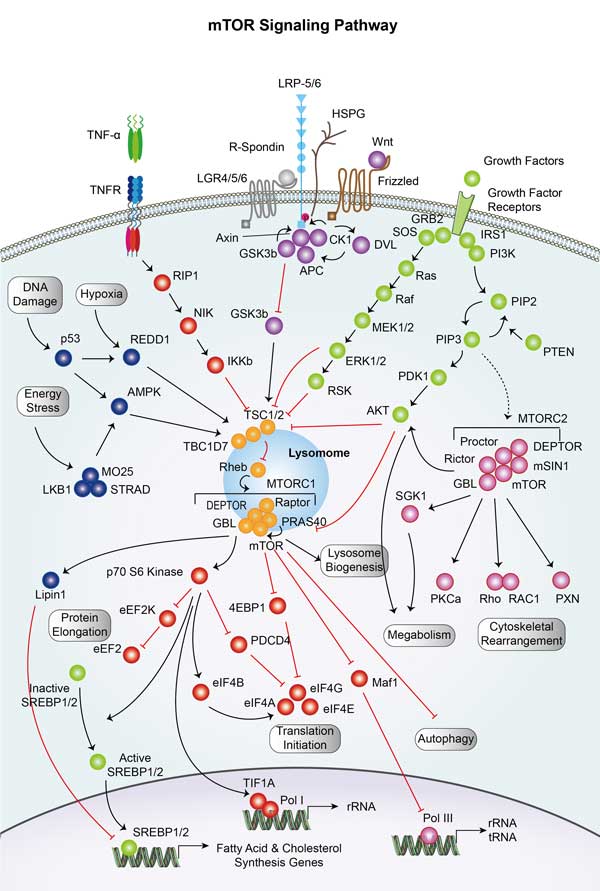Fzd8
-
Official Full Name
frizzled family receptor 8 -
Overview
This intronless gene is a member of the frizzled gene family. Members of this family encode seven-transmembrane domain;proteins that are receptors for the Wingless type MMTV integration site family of signaling proteins. Most frizzled;receptors are coupled to the beta-catenin canonical signaling pathway. This gene is highly expressed in two human;cancer cell lines, indicating that it may play a role in several types of cancer. The crystal structure of the;extracellular cysteine-rich domain of a similar mouse protein has been determined. -
Synonyms
FZD8;frizzled family receptor 8;frizzled (Drosophila) homolog 8 , frizzled 8, seven transmembrane spanning receptor , frizzled homolog 8 (Drosophila);frizzled-8;frizzled homolog 8;frizzled 8, seven transmembrane spanning receptor;FZ-8;hFZ8
Recombinant Proteins
- Mouse
- Human
- Rat
- Chicken
- Mus musculus
- Xenopus laevis
- Mammalian cells
- CHO
- Mammalian Cell
- HEK293
- Wheat Germ
- E.coli expression system
- Fc
- His
- His&Fc&Avi
- GST
- His&Avi
Involved Pathway
Fzd8 involved in several pathways and played different roles in them. We selected most pathways Fzd8 participated on our site, such as Wnt signaling pathway,Hippo signaling pathway,Signaling pathways regulating pluripotency of stem cells, which may be useful for your reference. Also, other proteins which involved in the same pathway with Fzd8 were listed below. Creative BioMart supplied nearly all the proteins listed, you can search them on our site.
| Pathway Name | Pathway Related Protein |
|---|---|
| Melanogenesis | WNT2BB,GSK3AA,WNT7A,PLCB4,FZD5,a,CAMK2B1,FZD3,GNAIA,CALM4 |
| Wnt signaling pathway | FZD7B,NLK2,PRKCG,PRKACBA,PRKACAA,PLCB3,PSEN1,TBL1XR1,FZD7A,RAC3 |
| Hippo signaling pathway | WWC1,PPP1CB,STK3,CTGF,FZD1,BMP4,BMP8B,LATS2,LATS1,YAP1 |
| Basal cell carcinoma | APC,FZD9,WNT5B,PTCH1,FZD2,TP53,WNT6,WNT11,GSK3B,WNT3 |
| HTLV-I infection | WNT6,POLD2,IKBKG,H2-AA,CALR,MSX2,HLA-DOA,TNFRSF1A,AKT1,Fzd4 |
| Signaling pathways regulating pluripotency of stem cells | FZD2,GSK3B,PIK3R3,NANOG,WNT8A,PCGF5,FZD5,FZD3,SKIL,PIK3R5 |
| Proteoglycans in cancer | FLNC,PRKACG,PAK1,VAV2,PIK3CD,SOS1,PDPK1,ARHGEF1,ROCK2,AKT2 |
| Pathways in cancer | BIRC7,WNT3A,NCOA4,LAMB2,Fgf15,GNG11,PLD1,FGF7,LAMA3,PIK3R3 |
Protein Function
Fzd8 has several biochemical functions, for example, G-protein coupled receptor activity,PDZ domain binding,Wnt-activated receptor activity. Some of the functions are cooperated with other proteins, some of the functions could acted by Fzd8 itself. We selected most functions Fzd8 had, and list some proteins which have the same functions with Fzd8. You can find most of the proteins on our site.
| Function | Related Protein |
|---|---|
| G-protein coupled receptor activity | OLFR1440,VMN1R47,APLNRB,Fzd4,AVPR2L,OPN5,GPR37B,GPR32,GPR139,PROKR1 |
| Wnt-activated receptor activity | FZD9B,FZD8B,FZD10,FZD5,FZD3A,FZD2,FZD6,Fzd4,FZD8A,FZD7B |
| PDZ domain binding | LLGL2,SLC26A6,F11R,FZD3,PLEKHA2,ATP2B1B,ATP2B1,DOCK4,DLG1,LPAR2 |
| protein binding | RBM25,LAMA4,EFNA4,TRIM24,MBL2,PHOSPHO2-KLHL23,FOXP1,AAK1,BRIP1,STX19 |
| receptor binding | ABCA1,PVRL1A,ACOT8,SMAGP,WNT4B,NOS2,ITGA1,PKD2,CNTFR,DDX54 |
| ubiquitin protein ligase binding | RB1,TRAF3,CKB,FOXO1,RNF34,PPARGC1A,IKBKG,EGR2,GSK3B,TRIB3 |
| Wnt-protein binding | GM12824,LRP2A,LRP5,FZD9B,FZD8B,LRP5L,FZD1,FZD9,FRZB,FZD3 |
Interacting Protein
Fzd8 has direct interactions with proteins and molecules. Those interactions were detected by several methods such as yeast two hybrid, co-IP, pull-down and so on. We selected proteins and molecules interacted with Fzd8 here. Most of them are supplied by our site. Hope this information will be useful for your research of Fzd8.
c1q_mouse_complex;WNT3A;SDCBP;C1qa
Fzd8 Related Signal Pathway
Resources
Related Services
Related Products
References
- Pauletto, M; Milan, M; et al. Insights into Molecular Features of Venerupis decussata Oocytes: A Microarray-Based Study. PLOS ONE 9:-(2014).
- Xiao, XA; Wang, P; et al. GPCR-2L: predicting G protein-coupled receptors and their types by hybridizing two different modes of pseudo amino acid compositions. MOLECULAR BIOSYSTEMS 7:911-919(2011).



